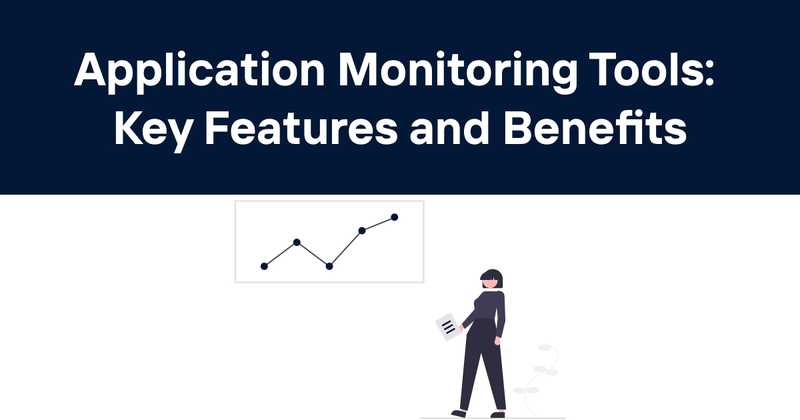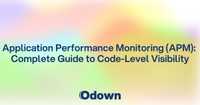Application Monitoring Tools: Key Features and Benefits
Table of Contents
- Introduction
- What Are Application Monitoring Tools?
- Key Features of Application Monitoring Tools
- Types of Application Monitoring
- Benefits of Using Application Monitoring Tools
- Choosing the Right Application Monitoring Tool
- Best Practices for Application Monitoring
- Common Challenges in Application Monitoring
- The Future of Application Monitoring
- Conclusion
Introduction
In the digital world, applications are the lifeblood of businesses. From e-commerce platforms to internal management systems, these digital tools drive operations, customer interactions, and revenue streams. But what happens when an application slows down or, worse, crashes entirely? The consequences can be dire - frustrated users, lost sales, and damaged reputations.
This is where application monitoring tools come into play. They're the unsung heroes of the tech world, quietly keeping watch over our digital ecosystems. But what exactly are these tools, and why are they so crucial? Let's dive in and explore the world of application monitoring tools.
What Are Application Monitoring Tools?
Application monitoring tools are software solutions designed to track, analyze, and report on the performance and health of applications. They act as a vigilant guardian, constantly checking various metrics and alerting teams when something goes awry.
These tools provide real-time insights into how applications are performing, helping teams identify and resolve issues before they impact users. They monitor everything from server response times to user interactions, giving a comprehensive view of an application's health.
But it's not just about catching problems. These tools also help optimize performance, ensuring applications run at their best. They can identify bottlenecks, track resource usage, and even predict potential issues before they occur.
Key Features of Application Monitoring Tools
Application monitoring tools come packed with features designed to give you a 360-degree view of your application's health. Here are some of the key features you'll find in most monitoring tools:
-
Real-time monitoring: These tools provide up-to-the-minute data on your application's performance. It's like having a constant health check-up for your app.
-
Performance metrics: They track crucial metrics like response time, throughput, and error rates. This data helps you understand how well your application is performing.
-
Alerting systems: When something goes wrong, you need to know ASAP. Good monitoring tools have robust alerting systems that notify the right people at the right time.
-
Log management: Logs are the black box of your application. Monitoring tools help collect, store, and analyze these logs to uncover insights and troubleshoot issues.
-
User experience monitoring: It's not just about server performance. These tools also track the end-user experience, helping you understand how real users interact with your application.
-
Resource utilization tracking: They monitor CPU, memory, and disk usage, helping you optimize resource allocation and prevent overutilization.
-
Visualization and reporting: Data is useless if you can't understand it. These tools provide dashboards and reports that make it easy to digest complex information.
-
Root cause analysis: When issues occur, these tools help you dig deep to find the underlying cause, not just treat the symptoms.
-
Application mapping: They create a visual representation of your application's architecture, helping you understand dependencies and potential bottlenecks.
-
Anomaly detection: Using machine learning algorithms, these tools can identify unusual patterns that might indicate a problem.
Remember, not all tools will have all these features, and some may have additional capabilities. The key is finding a tool that matches your specific needs.
Types of Application Monitoring
Application monitoring isn't a one-size-fits-all solution. There are several types of monitoring, each focusing on different aspects of application performance. Let's break them down:
-
Infrastructure Monitoring: This type focuses on the underlying hardware and software that your application runs on. It tracks things like server health, network performance, and storage capacity. It's like keeping an eye on the foundation of your house - if it's not solid, everything else is at risk.
-
Application Performance Monitoring (APM): APM tools dive deep into the application itself, tracking things like response times, transaction volumes, and error rates. They help you understand how your application is performing from the inside out.
-
Real User Monitoring (RUM): This type of monitoring looks at the application from the user's perspective. It tracks actual user interactions, helping you understand how real people are experiencing your application in the wild.
-
Synthetic Monitoring: Unlike RUM, synthetic monitoring uses scripted transactions to simulate user behavior. It's like having a robot constantly testing your application, even when real users aren't around.
-
Log Monitoring: Applications generate tons of log data. Log monitoring tools help you make sense of this data, uncovering patterns and insights that might otherwise go unnoticed.
-
Network Monitoring: This focuses on the communication between different parts of your application and the outside world. It helps ensure that data is flowing smoothly and securely.
-
Database Monitoring: For many applications, the database is a critical component. Database monitoring tools help optimize queries, track resource usage, and ensure data integrity.
-
Security Monitoring: With cyber threats on the rise, security monitoring is more important than ever. These tools help detect and respond to potential security breaches.
Each type of monitoring plays a crucial role in maintaining application health. In practice, most organizations use a combination of these monitoring types to get a complete picture of their application's performance.
Benefits of Using Application Monitoring Tools
Now that we've covered what application monitoring tools are and what they do, let's talk about why you should care. The benefits of using these tools are numerous and can have a significant impact on your business. Here are some of the key advantages:
-
Improved User Experience: By identifying and resolving issues quickly, you can ensure that your users have a smooth, enjoyable experience with your application. Happy users are loyal users, and loyal users are good for business.
-
Reduced Downtime: Monitoring tools can help you catch problems before they cause outages. And when issues do occur, these tools can help you resolve them faster. Less downtime means less lost revenue and fewer frustrated users.
-
Proactive Problem Solving: Instead of waiting for users to report issues, monitoring tools allow you to identify and address problems proactively. It's like fixing a leak before it floods your house.
-
Performance Optimization: These tools provide insights that can help you optimize your application's performance. Faster, more efficient applications lead to better user experiences and can even reduce infrastructure costs.
-
Capacity Planning: By tracking resource usage over time, monitoring tools can help you predict future needs. This allows you to scale your infrastructure intelligently, avoiding both over-provisioning and unexpected capacity issues.
-
Faster Troubleshooting: When issues do occur, monitoring tools provide the data you need to diagnose and resolve them quickly. No more hours spent trying to reproduce elusive bugs.
-
Better Collaboration: Many monitoring tools integrate with communication platforms, making it easier for teams to collaborate on problem-solving. They provide a common set of data that everyone can work from.
-
Compliance and Security: For applications dealing with sensitive data, monitoring tools can help ensure compliance with regulatory requirements and detect potential security threats.
-
Cost Savings: While there's an upfront cost to implementing monitoring tools, they can lead to significant savings in the long run. By preventing issues and optimizing performance, you can reduce infrastructure costs and avoid the financial impact of outages.
-
Continuous Improvement: The insights provided by monitoring tools don't just help you fix problems - they can also guide your development efforts, helping you continually improve your application over time.
Remember, the specific benefits you'll see depend on your unique situation and how you use the tools. But one thing's for sure: in today's digital landscape, robust application monitoring is no longer a luxury - it's a necessity.
Choosing the Right Application Monitoring Tool
With so many options on the market, choosing the right application monitoring tool can feel overwhelming. But don't worry - I'm here to help guide you through the process. Here are some key factors to consider:
-
Your Application's Architecture: Different tools are better suited for different types of applications. Are you running a monolithic application or a microservices architecture? Is it cloud-based or on-premises? Make sure the tool you choose is compatible with your setup.
-
Ease of Use: A tool is only useful if people actually use it. Look for solutions with intuitive interfaces and good documentation. If possible, try out a demo or free trial before committing.
-
Integration Capabilities: Your monitoring tool should play nice with your existing tech stack. Look for tools that integrate with your development tools, communication platforms, and other relevant systems.
-
Scalability: As your application grows, your monitoring needs will grow too. Choose a tool that can scale with you, both in terms of the volume of data it can handle and the number of users who can access it.
-
Customization Options: Every application is unique, and your monitoring setup should reflect that. Look for tools that allow you to customize dashboards, alerts, and reports to match your specific needs.
-
Data Retention and Analysis: Consider how long the tool retains data and what kind of analysis capabilities it offers. Long-term trend analysis can be incredibly valuable for capacity planning and continuous improvement efforts.
-
Cost: While it shouldn't be the only factor, cost is certainly important. Consider both the upfront costs and any ongoing fees. Remember to factor in potential savings from improved performance and reduced downtime.
-
Support and Community: Look for tools with strong support options and active user communities. These can be invaluable resources when you're troubleshooting issues or looking to get more out of the tool.
-
Security Features: If you're dealing with sensitive data, make sure the tool has appropriate security measures in place. This might include data encryption, access controls, and compliance certifications.
-
Future Development: The tech world moves fast. Look for tools with a track record of regular updates and a clear roadmap for future development.
Remember, there's no one-size-fits-all solution. The best tool for you is the one that best meets your specific needs and constraints. Don't be afraid to shop around, ask for demos, and really dig into the features of different tools before making a decision.
Best Practices for Application Monitoring
Having the right tools is just the first step. To get the most out of your application monitoring efforts, you need to use them effectively. Here are some best practices to keep in mind:
-
Set Clear Objectives: Before you start monitoring, know what you're trying to achieve. Are you looking to improve performance? Reduce downtime? Enhance security? Your objectives will guide your monitoring strategy.
-
Monitor the Right Metrics: Not all metrics are created equal. Focus on the ones that truly matter for your application and business goals. These might include response times, error rates, user engagement metrics, or business KPIs.
-
Establish Baselines: You can't improve what you don't measure. Establish baseline performance metrics so you can track improvements and quickly identify deviations from normal behavior.
-
Configure Meaningful Alerts: Alert fatigue is real. Set up your alerts carefully to ensure you're notified about important issues without being overwhelmed by false positives.
-
Use Visualization Effectively: Dashboards can be powerful tools, but only if they're well-designed. Create dashboards that provide at-a-glance insights into your application's health and performance.
-
Implement End-to-End Monitoring: Don't just focus on individual components. Implement tracing to understand how requests flow through your entire system.
-
Correlate Data from Different Sources: Often, the most valuable insights come from connecting the dots between different types of data. Look for patterns and relationships across different metrics and logs.
-
Automate Where Possible: Use automation to handle routine tasks like log analysis, report generation, and even some types of problem resolution.
-
Keep Security in Mind: Ensure that your monitoring practices don't create security vulnerabilities. Be careful about what data you collect and how you store it.
-
Continuously Refine Your Approach: As your application evolves, so should your monitoring strategy. Regularly review and adjust your monitoring setup to ensure it's still meeting your needs.
-
Foster a Culture of Monitoring: Monitoring shouldn't be the sole responsibility of the ops team. Encourage developers to build monitoring into their code and make performance data accessible to all relevant stakeholders.
-
Plan for Incident Response: Monitoring is most valuable when it leads to action. Have clear processes in place for how to respond when monitoring alerts are triggered.
Remember, effective monitoring is an ongoing process, not a set-it-and-forget-it task. Stay engaged, keep learning, and don't be afraid to experiment with new approaches.
Common Challenges in Application Monitoring
While application monitoring tools can provide immense value, implementing and maintaining an effective monitoring strategy isn't without its challenges. Here are some common hurdles you might face, along with tips on how to overcome them:
-
Data Overload: With so many metrics available, it's easy to get overwhelmed by data. Solution: Focus on key performance indicators (KPIs) that align with your business objectives. Start small and gradually expand your monitoring scope as needed.
-
False Positives: Overly sensitive alerts can lead to alert fatigue and missed important issues. Solution: Fine-tune your alert thresholds based on historical data and business impact. Use anomaly detection algorithms to reduce false positives.
-
Lack of Context: Raw data without context can be misleading or unhelpful. Solution: Correlate monitoring data with business events and user behavior. Implement tracing to understand the full context of transactions.
-
Tool Sprawl: Using too many disparate tools can lead to silos and inefficiency. Solution: Look for integrated solutions that cover multiple aspects of monitoring. If you must use multiple tools, ensure they can integrate and share data effectively.
-
Skills Gap: Modern monitoring tools can be complex, requiring specialized skills to use effectively. Solution: Invest in training for your team. Look for tools with good documentation and user-friendly interfaces. Consider managed services if you lack in-house expertise.
-
Monitoring in Dynamic Environments: Cloud-native and containerized applications can be challenging to monitor due to their dynamic nature. Solution: Use monitoring tools designed for cloud-native environments. Implement auto-discovery features to keep up with changing infrastructure.
-
Cost Management: As data volumes grow, the cost of monitoring can spiral. Solution: Implement data sampling and aggregation strategies. Regularly review and optimize your monitoring setup to ensure you're not collecting unnecessary data.
-
Privacy and Compliance: Monitoring activities can potentially violate privacy laws or compliance requirements if not handled carefully. Solution: Be mindful of what data you're collecting and how it's stored. Implement strong access controls and data protection measures. Consult with legal experts if necessary.
-
Lack of Actionable Insights: Collecting data is one thing, but deriving meaningful insights is another. Solution: Invest in analytics capabilities. Use machine learning algorithms to uncover patterns and predict issues. Focus on turning data into actionable recommendations.
-
Resistance to Change: Implementing new monitoring practices can face resistance from teams used to old ways of working. Solution: Communicate the benefits of effective monitoring. Involve teams in the selection and implementation of monitoring tools. Celebrate wins and share success stories.
Remember, these challenges are not insurmountable. With the right approach and tools, you can overcome these hurdles and build a robust, effective monitoring strategy.
The Future of Application Monitoring
As technology continues to evolve at a breakneck pace, so too does the field of application monitoring. Let's gaze into our crystal ball and explore some of the trends that are shaping the future of this crucial discipline:
-
AI and Machine Learning: Artificial intelligence and machine learning are already making waves in application monitoring, and their influence is only going to grow. These technologies will enable more sophisticated anomaly detection, predictive analytics, and automated problem resolution.
-
Observability: While monitoring tells you when something is wrong, observability helps you understand why. Expect to see a continued shift towards observability practices, with a focus on distributed tracing, detailed logging, and rich metadata.
-
AIOps: AIOps (Artificial Intelligence for IT Operations) takes AI a step further, using machine learning and big data analytics to automate and enhance IT operations processes. This will lead to more proactive and efficient monitoring practices.
-
Edge Computing Monitoring: As more processing moves to the edge to support IoT devices and low-latency applications, monitoring tools will need to adapt to effectively monitor these distributed environments.
-
Increased Focus on User Experience: While technical metrics will always be important, expect to see more emphasis on monitoring the actual user experience. This includes things like real user monitoring (RUM) and sentiment analysis.
-
Security Integration: With cyber threats on the rise, the line between application monitoring and security monitoring will continue to blur. Expect to see more integrated solutions that cover both performance and security monitoring.
-
Containerization and Microservices: As more applications move towards containerized and microservices architectures, monitoring tools will need to become even more adept at handling these dynamic, distributed environments.
-
Open Standards: Initiatives like OpenTelemetry are pushing for more standardization in the monitoring space. This could lead to better interoperability between tools and more flexibility for users.
-
Scalability and Performance: As applications generate more and more data, monitoring tools will need to become even more efficient at ingesting, processing, and storing this data at scale.
-
Privacy-Aware Monitoring: With increasing focus on data privacy (driven by regulations like GDPR and CCPA), monitoring tools will need to become more sophisticated in how they handle potentially sensitive data.
-
Low-Code/No-Code Monitoring: As with many other areas of tech, we might see a rise in low-code or no-code solutions for application monitoring, making these tools more accessible to a wider range of users.
-
Blockchain Monitoring: As blockchain technology becomes more mainstream, we'll likely see more specialized tools for monitoring blockchain networks and applications.
The future of application monitoring is exciting and full of potential. By staying ahead of these trends, you can ensure that your monitoring practices remain effective and relevant in the face of evolving technology landscapes.
Conclusion
Application monitoring tools are more than just a technical necessity - they're a business imperative. In a world where digital experiences can make or break a company, having robust, effective monitoring in place is crucial.
We've covered a lot of ground in this article, from understanding what application monitoring tools are and their key features, to best practices for implementation and future trends. The key takeaway is this: effective application monitoring is about more than just tracking metrics. It's about gaining deep insights into your application's behavior, predicting and preventing issues before they impact users, and continuously improving your digital offerings.
Remember, the right monitoring tools and practices can help you deliver better user experiences, reduce downtime, optimize performance, and ultimately, drive business success. But it's not a one-time setup - it requires ongoing attention, refinement, and adaptation as your applications and the broader technology landscape evolve.
As we wrap up, it's worth mentioning Odown, a powerful tool in the application monitoring space. Odown offers robust website uptime monitoring for both websites and APIs, ensuring your digital assets are always performing at their best. Their public status pages keep your users informed, building trust and transparency. And with their SSL certificate monitoring tool, you can ensure your site's security is always up to par. For those looking to step up their application monitoring game, Odown is definitely worth considering.
In the end, the goal of application monitoring is simple: to ensure that your applications are always working as intended, delivering value to your users and your business. With the right tools and practices in place, you can turn this goal into a reality.



